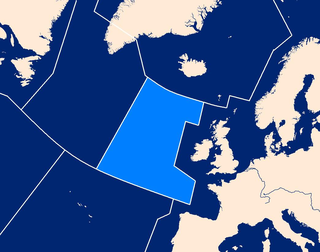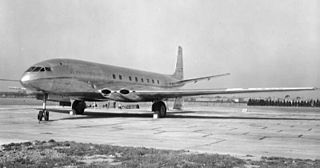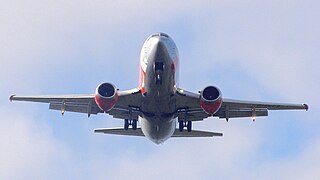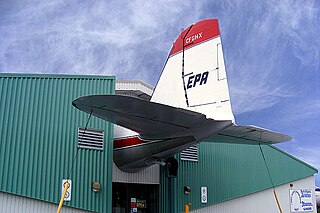Transatlantic crossings are passages of passengers and cargo across the Atlantic Ocean between Europe or Africa and the Americas. The majority of passenger traffic is across the North Atlantic between Western Europe and North America. Centuries after the dwindling of sporadic Viking trade with Markland, a regular and lasting transatlantic trade route was established in 1566 with the Spanish West Indies fleets, following the voyages of Christopher Columbus.

ETOPS is an acronym for Extended-range Twin-engine Operations Performance Standards—a special part of flight rules for one-engine-inoperative flight conditions. The International Civil Aviation Organization (ICAO) coined the acronym for twin-engine aircraft operation in airspace further than one hour from a diversion airport at the one-engine-inoperative cruise speed, over water or remote lands, or on routes previously restricted to three- and four-engine aircraft.
NATS Holdings, formerly National Air Traffic Services and commonly referred to as NATS, provides en-route air traffic control services to flights within the UK flight information regions and the Shanwick Oceanic Control Area. It also provides air traffic control services to 14 UK airports.
Gander is a town located in the northeastern part of the island of Newfoundland in the Canadian province of Newfoundland and Labrador, approximately 40 km (25 mi) south of Gander Bay, 100 km (62 mi) south of Twillingate and 90 km (56 mi) east of Grand Falls-Windsor. Located on the northeastern shore of Gander Lake, it is the site of Gander International Airport, once an important refuelling stop for transatlantic aircraft. The airport is still a preferred emergency landing point for aircraft facing on-board medical or security issues.
A transatlantic flight is the flight of an aircraft across the Atlantic Ocean from Europe, Africa, South Asia, or the Middle East to North America, Latin America, or vice versa. Such flights have been made by fixed-wing aircraft, airships, balloons and other aircraft.

Gander International Airport is located in Gander, Newfoundland and Labrador, Canada, and is operated by the Gander International Airport Authority. Canadian Forces Base Gander shares the airfield but is a separate entity from the airport. The airport is sometimes referred to as the "Crossroads of the World", and is classified as an international airport by Transport Canada.

Shanwick is the air traffic control (ATC) name given to the area of international airspace which lies above the northeast part of the Atlantic Ocean.

Bangor International Airport is a joint civil-military public airport on the west side of the city of Bangor, in Penobscot County, Maine, United States. Owned and operated by the City of Bangor, the airport has a single runway measuring 11,440 by 200 ft. Formerly a military installation known as Dow Air Force Base, Bangor International Airport remains home to the 101st Air Refueling Wing of the Maine Air National Guard, although most of the Air Force's aircraft and personnel left in the late 1960s. BGR covers 2,079 acres of land. It is included in the Federal Aviation Administration (FAA) National Plan of Integrated Airport Systems for 2023–2027 categorized it as a non-hub primary commercial service facility.

The Jet Age is a period in the history of aviation defined by the advent of aircraft powered by jet turbine engines and the social and cultural changes fostered by commercial jet travel.

Bluie West One, later known as Narsarsuaq Air Base and Narsarsuaq Airport, was built on a glacial moraine at what is now the village of Narsarsuaq, near the southern tip of Greenland. Construction by the United States Army began in June 1941. The first aircraft landed there in January 1942, as a link in the North Atlantic air ferry route in World War II. The base had a peak population of about 4,000 American servicemen, and it is estimated that some 10,000 aircraft landed there en route to the war in Europe and North Africa.

Stephenville Dymond International Airport is an airport located 1 nautical mile south southeast of Stephenville, Newfoundland and Labrador, Canada. It was built by the United States Army Air Forces and operated as Ernest Harmon Air Force Base from 1941 to 1966.

Kuujjuaq Airport is an airport located 1.5 nautical miles southwest of Kuujjuaq, Quebec, Canada.

A twinjet or twin-engine jet is a jet aircraft powered by two engines. A twinjet is able to fly well enough to land with a single working engine, making it safer than a single-engine aircraft in the event of failure of an engine. Fuel efficiency of a twinjet is better than that of aircraft with more engines. These considerations have led to the widespread use of aircraft of all types with twin engines, including airliners, fixed-wing military aircraft, and others.

Cheddi Jagan International Airport, formerly Timehri International Airport, is the primary international airport of Guyana. The airport is located on the right bank of the Demerara River in the city of Timehri, 41 kilometres (25 mi) south of Guyana's capital, Georgetown. It is the larger of the two international airports serving Georgetown with the other airport being the Eugene F. Correia International Airport.

Narsarsuaq Airport is an airport located in Narsarsuaq, a settlement in the Kujalleq municipality in southern Greenland. Along with Kangerlussuaq Airport, it is one of two airports in Greenland capable of serving large airliners. It is also the only international airport in southern Greenland. The settlement it serves is small, with the airport primarily functioning as a transfer point for passengers heading for the helicopter hubs of Air Greenland in Qaqortoq and Nanortalik. The airport is to be closed in 2025 when Qaqortoq Airport is scheduled to open.

The North Atlantic Aviation Museum is an aviation museum located in the town of Gander, Newfoundland and Labrador, Canada.
A polar route is an aircraft route across the uninhabited polar ice cap regions. The term "polar route" was originally applied to great circle navigation routes between Europe and the west coast of North America in the 1950s.

The North Atlantic air ferry route was a series of Air Routes over the North Atlantic Ocean on which aircraft were ferried from the United States and Canada to Great Britain during World War II to support combat operations in the European Theater of Operations (ETO).
AirTanker Services Limited, incorporated in England and Wales on 14 June 2007, is a private limited company in the United Kingdom (UK), which operates a British airline known as AirTanker, and is also an aircraft leasing and operating company.

On 11 September 1990, a Faucett Perú Boeing 727 airliner, registered OB-1303, disappeared in an area of the Atlantic Ocean approximately 180 miles southeast of Cape Race, Newfoundland, Canada. The aircraft was being ferried back from Malta to Peru after having been leased to Air Malta, and had six crewmembers on board as well as ten passengers consisting of airline employees and their families. The last contact with the crew was a distress message stating that the aircraft had run out of fuel and that they were preparing to ditch. The aircraft was hundreds of miles off course at the time. Nothing more was ever heard from the flight, and no trace of the aircraft or any of the occupants has since been found.














